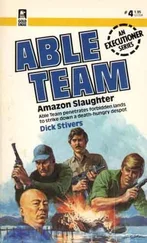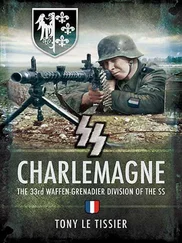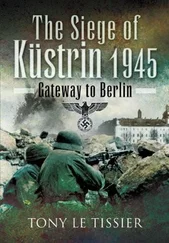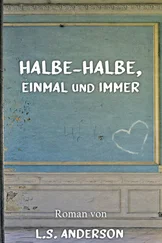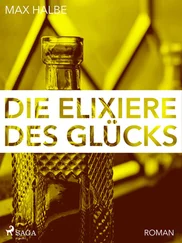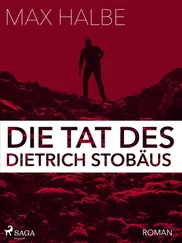Rieben was taken by storm, but the break-out group kept coming up against more and more Russian blockades. The mass of German soldiers and civilians, not bound to the roads and tracks like the vehicles, swarmed their way westwards between Zauchwitz and Rieben. Seydlitz-Troops were particularly active in this area, leading unsuspecting splinter groups into Soviet captivity. [5] Tieke, Das Ende zwischen Oder und Elbe , p. 339.
Streng then went on to describe the fighting between Rieben and Schönefeld:
Warm spring sunshine was streaming over the land. It was 1000 hours. We moved on. Some wounded emerged from an asparagus field [6] The area around Beelitz is famous for its asparagus crops. The asparagus fields with their deep corrugations would provide some measure of cover from fire for the troops sheltering there.
and clung tightly to the exterior of our Königstiger, these unfortunates lying all over the tank from our gun to our stern. Actually we were feeling quite happy, being hopeful of reaching Wenck’s Army during the course of the day.
We rolled along the road to Beelitz. Troops came out of the woods and asparagus fields and marched behind us. We speeded up. If only we had had better communications inside the tank; every order had to be shouted.
The tank stopped again. An anti-tank gun on the road was swept aside with a blast of high explosive. Half left stood a Russian tank. ‘Armour piercing!’ The Tiger’s turret turned slowly left. Fire! Hit! Clouds of smoke obscured the view.
Suddenly there was a metallic crack on the tank’s right side and a long drawn-out hissing. A blinding whiteness sprayed in from outside. There was dead silence for a second. We must have overlooked a Russian tank on our right. A white cloud of smoke filled the interior of the tank and a wave of heat took our breath away.
The tank was on fire. Everyone fumbled for the escape hatches to get to the open air. Tongues of bright flame burned our unprotected hands, upper bodies and faces. Heads and bodies collided with each other as hands unfastened the hot escape hatches. Vital air entered the lungs as racing pulses hammered in the throat and brain. A purplish blackness pierced by green flashes filled my eyes.
I grasped the hatch with flying hands, wriggled and thrust myself through, standing on the breech shield and gun. Two heads met in the hatch. I instinctively pulled Läbe up and pushed him out of the top of the turret with my head and body. I caught my leather jacket on a hook, ripping it off my body and it fell back into the burning tank with a final flash of silver from the Iron Cross.
I let myself fall head over heels from the three-metre high turret, pushing myself away from the sides with my hands as I fell. In falling I saw that the skin of my left forefinger had been torn loose, so I tugged it off, leaving a bloody something.
The burning, reeling figure of the radio-operator jumped right in front of me. Hartinger, Neu and Öls ran past. Was anyone still inside? The tank exploded behind us, the 18-ton turret lifting off and being hurled aside. This was the end. [7] Tieke, Das Ende zwischen Oder und Elbe , pp. 340–1.
Rudi Lindner also witnessed this event, as he described in his account of his experiences that day:
We had to cross several open spaces during the night, and each time the infantry and tanks were called forward. There was repeated fighting and shooting. When we had to take cover we tried to make sure that we five stayed together. With this came great fatigue, hunger and thirst. We wanted simply to remain lying there with the consequent danger of falling asleep. It cost us much effort to keep forcing ourselves on and stay awake. We avoided the open spaces and tried to remain in the woods, which was not always possible. I am still amazed today that we managed to maintain contact with the leading tanks in this unholy turmoil.
Everywhere there was gunfire and cries from the wounded. The dead lay around as we overcame several enemy positions and cordons. The 12th Army’s front line should be immediately behind the last Russian cordon, but would we ever reach it alive? Our leading tank drove out of the woods, was immediately engaged by the Russian anti-tank guns, and pulled back again. There was now artillery fire on our edge of the woods and we had to turn south to get away from the road. About 15 minutes later our last two Tigers attacked out of the woods to the north of us and a broad stream of soldiers and refugees poured over the open ground to the west and north-west.
Unfortunately, as we discovered later, that was the most strongly manned sector of the Russian cordon between Schönefeld and Wittbrietzen. The Russians fired flat out with tanks, anti-tank guns, Stalin-Organs, artillery and mortars on the defenceless people in the open ground, and bombers and ground-attack aircraft joined in. Death struck viciously again and reaped a rich harvest. There was no cover for the soldiers and civilians, who were completely exposed to this murderous fire. Mercilessly, the remains of 9th Army were being given their death blow only a few hundred metres from the protection of 12th Army’s front line.
Of the heavy tanks we now only had Klust’s Königstiger from No. 1 Company and Streng’s from No. 2 Company. Streng’s tank had been hit several times during this decisive breakthrough. Even so, he was still able to engage in a tank duel and knock out three T-34s, but then his tank was hit by an anti-tank gun and burst into flames. After a dozen severe hits, this time the tank could not be saved. It was the tank that I had been on in Halbe and which had been hit by a phosphorous shell and caught fire there. A few minutes later SS-Second Lieutenant Klust’s tank was also knocked out, thus writing off the last of the 14 Tiger tanks which 9th Army had sent to join up with 12th Army.
For the first time I held my four comrades of the 1241st Regiment back from attacking as we had done so often in the last days and weeks. We remained lying at the edge of the woods and watched the course of the uneven fight. It was not fear or cowardice, but military common sense and combat experience that led me to this decision, its correctness being demonstrated only a few minutes later.
An APC with Hitler Youth leaders appeared from the left flank and drove into cover near us. They had the task of warning the remains of 9th Army about this strong enemy cordon and were meant to direct us south-west towards Wittbrietzen. These youngsters looked just like Seydlitz-Troops. What an irony of fate for the many who had fallen on this open ground and the soldiers and civilians who had been wounded.
While death awaited north of Wittbrietzen, the way south of it was ‘an easy walk’ to 12th Army’s front line. Had this APC with its certainly courageous crew arrived only two or three hours earlier, 9th Army’s spearhead could have been directed in this direction.
With unfortunately so few soldiers, we turned to the south-west and within about 1,200 metres reached the described spot under cover of the woods, from where it was only a short distance over open ground to the woods opposite. The men of 12th Army dug in on the edge of the woods were expecting us and directed us back behind the railway line.
We could hardly believe that we had managed to make the last section alive, and without having fired a shot. It was only later that we realised how often death had stretched out a finger towards us, in the purest sense our constant companion, and what enormous luck we had had to belong to the few to have survived the fighting on the Oder Front, the Hell of Halbe and the death march to 12th Army’s lines. [8] Lindner in the author’s Death Was Our Companion .
SS-Lieutenant Klust, commander of the other Königstiger in this group, gave a slightly different account of his experiences during this final stage:
Читать дальше

